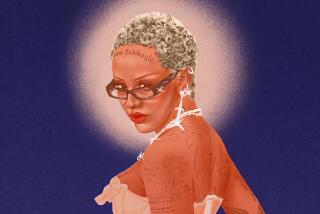Bling of the road
As Cadillac heads down the road, what kind of music is on the stereo?
The GM luxury division’s “Break Through” television ad campaign defibrillates viewers’ hearts with Led Zeppelin’s 1971 classic “Rock and Roll.” Let us not kid ourselves. This ad campaign is aimed primarily at white boomers, affluent suburbanites as young as 44 and as old as, say, Robert Plant and Jimmy Page, rock gods who are spending entirely too much time in the bathroom.
Yet Cadillac’s biggest fans are at the other end of pop culture’s radio dial. According to a survey by San Francisco-based marketing analyst Lucian James, Cadillac became the most name-dropped brand in songs on Billboard’s Top 20 chart in January 2004, overtaking Mercedes-Benz, which has long been hip-hop’s shibboleth of bling-bling materialism. (Other names to watch on James’ “American Brandstand” list include Lexus, Hennessey, Cristal and Gucci.)
In Los Angeles in February, GM staged the “All-Star Showdown,” a charity event at which prominent athletes and celebrities, mostly African Americans -- including Shaquille O’Neal, Busta Rhymes, Public Enemy and Martin Lawrence -- competed for the title “King of Bling” with their pimped-out Cadillac Escalades and Hummer H2s.
Five years ago, Cadillac was about as hip as wingtips. Today the brand is on the bleeding edge of what’s cool, a fixture in urban music and cherished ride of some of Dub Nation’s biggest superstars. How did all this happen?
“It’s been a totally great surprise,” Cadillac General Manager Mark LaNeve told Automotive News last week. “In terms of generating anything that is targeted to that group, no, we can’t take credit for it. We’re too busy to know what’s cool.”
Word up. Cadillac now finds itself curiously suspended between two demographics with very different sensibilities, which -- let’s keep it real, yo -- don’t have much to do with each other. For all the talk about hip-hop going mainstream, and crossover hits such as OutKast’s “Hey Ya!” (“Don’t want to meet your daddy/Just want you in my Caddy”) you are not going to find white middle-aged soccer moms swapping out their Sting CDs so they can rattle windows with Youngbloodz’s “Cadillac Pimpin.” And, outside of commercials, you almost never hear Led Zep in South Central.
Marketing maven James likes to talk about how brand names operate in hip-hop as metaphor, as compressed bits of meaning; in a word, poetry. When 50 Cent raps about taking a woman back to the Ramada Inn, “Obviously that suggests a different kind of evening than if he were taking her to the Four Seasons,” says James.
Cadillac was there first. It is one of the most metaphoric brand names in pop culture. The ASCAP and BMI catalogs list hundreds of songs and artists invoking the Cadillac name, one way or another. From the cheerful:
My love bigger than a Cadillac ...
I’ll try to show it when you’re driving me back
-- Buddy Holly, “Not Fade Away”
To the dire:
Alabama, you got the weight on your shoulders
That’s breaking your back
Your Cadillac has got a wheel in the ditch
And a wheel on the track
-- Neil Young, “Alabama”
There are Cadillacs parked in every corner of the music store. In the country section, the selection runs from Bob Wills’ “Cadillac in Model ‘A’ ” to Dwight Yoakam’s “Guitars Cadillacs Etc.” In rock, from Chuck Berry’s “Maybelline” to Bruce Springsteen’s “Cadillac Ranch.” Novelty songs? We got ‘em. Johnny Cash’s “One Piece at a Time” is about an assembly line worker who smuggles a new Cadillac out of the factory in his lunchbox.
And that’s not even touching the rockabilly/punkabilly genre -- from Eddie Cochran to the Fabulous Thunderbirds -- with its fuzzy dice irony and bowling shirt cool. Suffice to say if you wanted to reorganize Tower Records, you could create a whole section under the Cadillac heading.
The rise of Cadillac in hip-hop culture begins with the American bluesmen of the mid-20th century at a time when the name Cadillac was the definition of excellence and the cars were automotive totems of the ruling class. Howlin’ Wolf, Buddy Guy and Lightnin’ Hopkins were itinerant artists, working a vast territory from Chicago to Texas to the Mississippi Valley, and so a fine car was a very practical aspiration.
They were also black men in Jim Crow’s South and, if that weren’t
marginalization enough, they were
musicians. For these artists, the
Cadillac -- the ultimate status symbol for white America -- was all the more potent as evidence of worth and achievement.
Not surprisingly, given the blues’ love of innuendo, the “long black Cadillac” became a metaphor of prowess, both economic and sexual.
I love a Cadillac, it’s a long wreckin’ machine ...
I’m gonna drive this automobile, just as long as the gas lasts.
-- Howlin’ Wolf, “Cadillac Daddy”
Flash-forward to 1968 and the birth of funk, with James Brown’s black identity anthem “Say it Loud.” The blues’ covert sexuality gave way to funk’s explicitness, as in Brown’s “Sex Machine.” Afros, dashikis, platform shoes and brilliantly colored suits became standard stage wear for bands like Sly & the Family Stone.
The exuberances of funk fashion morphed into the dandified “pimp” style favored by the crushed-velvet, gold-toothed sex entrepreneurs we would now call “players.”
And Cadillac was along for the ride.
The pettifogging pimp in the Caddie quickly became a stock character in Hollywood, either as comic relief (think Starsky & Hutch’s Huggy Bear, played in the new movie by Snoop Dogg) or as a heavy, supplying target practice for Clint Eastwood or Charles Bronson. In the blaxploitation films “Superfly,” “The Mack” and “Willie Dynamite,” we meet the hustler as hero, the mack daddy as the wise and amoral trickster. Ron O’Neal’s “Superfly” character, though not strictly a pimp, has the look, from floor-length trench coat to massive gold-grilled Cadillac Eldorado.
In Detroit, it’s fair to assume that General Motors’ marketing executives were probably dismayed that the noble Cadillac had become the official ride of the crushed-velvet set.
White America was fostering its own backlash against Cadillac, a mood captured in the 1972 Guy Drake country song “Welfare Cadillac,” which lampooned public assistance as coddling the poor and shiftless:
We get peanut butter and cheese
And man, they give us flour by the sack
‘Course them Welfare Checks
They meet the payments on this new Cadillac.
While the implied narrator of this song was white, there was no mistaking its ugly racial intent.
So by the early 1970s, the Cadillac brand found itself riding around with a trunk full of stereotypes -- pimpmobile, welfare Cadillac. For the next three decades, the marketing department at Cadillac avoided any association with the African American demographic. When Cadillac general manager LaNeve says the division didn’t “target” hip-hop culture, he is artfully shading the story.
But a funny thing happened on the way to the 21st century: Pimpin’ went mainstream.
You might start the clock running in 1988, with N.W.A’s “Straight Outta Compton,” the epitome of gangsta rap and a kind of psychic template for hip-hop to come. Gangsta rap is an amplification of funk’s sensibility, except that instead of political empowerment for many, its energy is derived from the self-glorification of the narrator, the ruthless criminal-as-hero, the gangsta, the “playa” in ostentatious jewelry, cars and clothes.
Gangsta was also “street”: The most credible artists rapped about their own experiences. One of rap’s most influential figures -- and the one, by my reckoning, most responsible for popularizing “pimp” -- is Ice-T.
The O.G. (“Original Gangster”) was, in fact, a fairly significant criminal, an L.A. gang member with the bullet holes to prove it. Ice-T proved deft at show business and is now a successful actor, with more than a dozen movie credits and a starring role on TV’s “Law and Order.”
He is also the new Godfather of Pimp. Ice-T added the celebrity voltage to Brent Owens’ debauched pimpumentary “Pimps Up, Ho’s Down” (1999) set against the backdrop of the annual Players Ball.
“Pimps Up” was followed in quick succession by the Hughes Brothers’ “American Pimp” (2000), and by the time “Snoop Dogg’s Hustlaz” hit video shelves in 2002, pimp was a full-blown phenomenon, and these Caddy-driving Caligulas were well on their way to cult stardom.
Scene was so thick, low rides, seventy-seven Sevilles
El Dawgs, nuttin but them ‘llacs
All the players, all the hustlers, i’m talking about
Black man heaven, yah know what i’m saying?
-- OutKast, “Player’s Ball”
Pimp also created synergy with the Latino low-rider movement that had emerged from Southern California and flourished into an automotive art form of its own.
This fusion of pimp, low-rider and Asian tuner car styles is largely responsible for the current mania for oversized polished wheels -- dubs -- as well as LED lights, outlandish entertainment systems and ground-hugging body work.
How mainstream is it? Consider MTV’s new show, “Pimp My Ride,” hosted by hip-hop artist Xzibit, or Spike TV’s “Ride With FunkMaster Flex,” which follows the hip-hop DJ as he visits celebrities “illest” custom jobs.
According to the Specialty Equipment Manufacturing Assn., the trade group for automotive aftermarket suppliers, the market for dubs -- custom wheels -- represents over $3 billion annually.
For Cadillac, the tipping point came with the 1999 introduction of the Cadillac Escalade, a full-size SUV (based on the Chevy Tahoe) loaded with luxury and trimmed out with dramatic, knife-edge styling. The Escalade became a hit with many African American athletes, in part because pro basketball players often had a hard time folding themselves into a Bentley Azure.
Suddenly, players had a new Cadillac. The ‘Slade quickly became the image ride for the brand-obsessed hip-hop culture. In 2003, Cadillac’s truck sales -- Escalade, ESV, ETX, SRX -- grew almost 20% over the previous year, while its car sales were flat.
But more important than per-unit profit is the priceless exposure for the Cadillac brand in a trend-setting demographic it could never have thought of reaching on its own. For example, Chingy’s ballad-like “One Call Away,” currently in heavy rotation on music video networks, features him kickin’ it in a Cadillac XLR.
When you think about it, what has happened to Cadillac is remarkable. A brand once desperate for respect and attention is suddenly outpointing Gucci, Courvoisier, Bentley and its German rival Mercedes-Benz in brand awareness among consumers 18 to 24 years old, the mother lode of marketing demographics.
Yet all that glitters is not bling. Pimpin’ is, after all, about sexual exploitation of women. And while it’s easy to laugh while watching MTV’s “Pimp My Ride,” there is plenty in hip-hop that Cadillac would do well to keep at arm’s length.
For instance, the XLR-driving Chingy also collaborates with Snoop Dogg and Ludacris on “Holidae Inn,” a three-way, if you will, about a drug-sotted orgy at a hotel. The sunny sweetness of OutKast’s “Hey Ya” must be balanced against another song’s gun-waving effrontery:
I swear to God I got the highest boomin Cadillac
The expialalistic Coupe de Ville
Can you handle that you rat
And under my seat for you suckers, it’s your final curtain call
The one-two to the gauge
p-u-m-p.
-- OutKast, “Southernplay-
alisticaddilacmuzik”
In a country where Janet Jackson’s brief glandular grandstanding at the Super Bowl shook Congress to its blue stockings, hip-hop’s aesthetic remains too raunchy and lawless for general consumption. “We would be vehemently opposed to any lyrics about violence and drugs,” LaNeve told Automotive News. “But we can’t control that. Our attitude would be to stay out of it. If something came up that is portrayed as harmful to society or the product image, we would try to look into that.”
If? Do they get MTV in Detroit?
In the long term, Cadillac might have a hard time enjoying the image windfall of all things bling while avoiding what you might call gilt by association.
Led Zeppelin stays. The song remains the same.
Times automotive critic Dan Neil can be reached at dan.neil@latimes.com.






